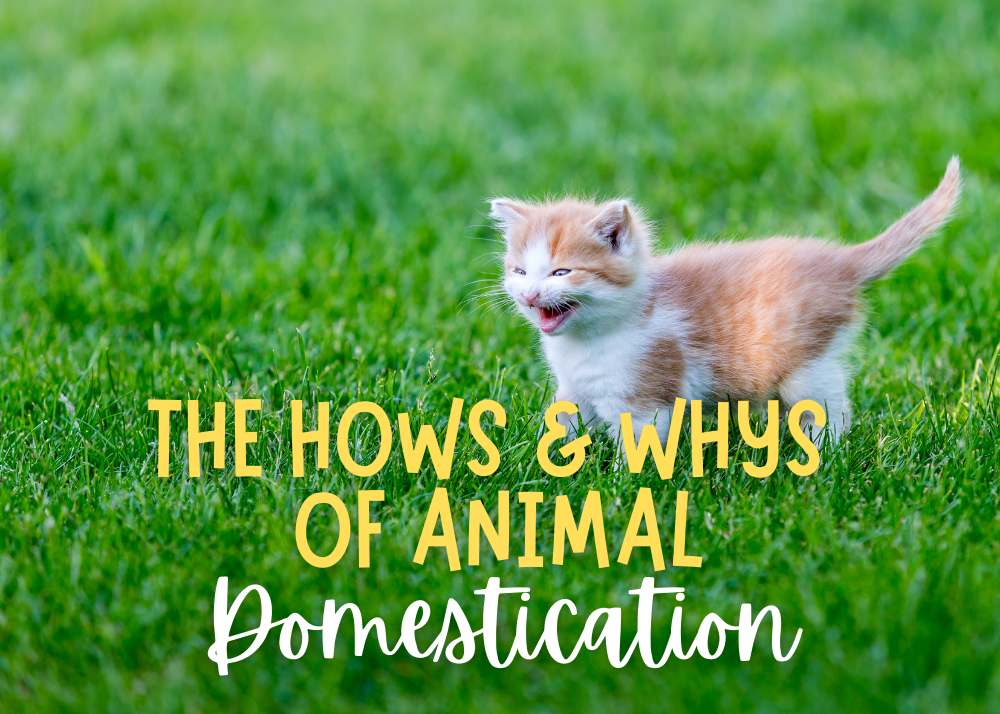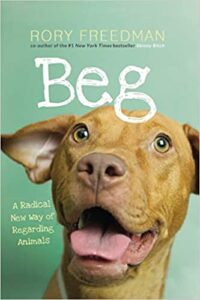LIBRARY BLOG
The Hows and Whys of Animal Domestication

What does “domestication” mean?
When an animal is considered “domesticated” it means that this animal has gone through the process of being tamed and is then kept as a pet or on a farm by humans, and over time these animals may develop traits that make them more suitable for human interaction and use. This is a process that has been going on for thousands of years! For an animal to be considered domesticated rather than merely tame the species must live in captivity and be selectively bred by humans for more than 10 generations. Beyond the 10-14 generations it takes for an animal species to be considered domesticated, the DNA of this animal must be different than its ancestors due to the selective breeding traits will change. For example, a human will only choose to breed the least aggressive of the animals and allow the more aggressive ones to die off. After continuously doing this over many generations, the gene that made the animal aggressive will no longer be present in its DNA.
What is the first animal to be domesticated?
The very first animal to be domesticated was the dog over 10,000 years ago. This is before humans began cultivating their own crops for food, which means humans were still living a nomadic lifestyle hunting and foraging for food. Humans during this time used their dogs as a form of protection, hunting companions, sled pullers, and a source of warmth.
So... why can’t all animals be domesticated?
As stated by Jared Diamond in his non-fiction book Guns, Germs, and Steel an animal must meet 6-part criteria to be able to be domesticated and not all animals meet these requirements:

1. Domestic animals must be able to find food in and around human settlements, meaning they must have a diverse appetite. Dogs were domesticated from the wolf species which only ate meat. Over time the wolf began to become more accustomed to a human diet. To digest things like potatoes and corn the digestive system of the dog gradually changed over time. Once humans established agriculture their dogs could also gain sustenance from crops rather than only meat.
2. Domestic animals must mature rapidly (in relation to a human lifespan). For example, elephants check most boxes for domestication except this one because it may take them up to 15 years to reach their full growth, which is not sustainable for human needs.
3. Domestic animals must be willing to breed in captivity. This may seem like an odd one but here is a notable example: the ancient Egyptian royalty and upper class kept cheetahs as house pets and hunting companions. The reason? Cheetahs have a friendly nature and didn’t show fear of humans. Fully grown cats were easily trapped, tamed, and not so easily trained to be kept as house pets, but because of their extensive courtship and mating rituals the big cats were unable to reproduce in captivity.
4. An animal must be docile by nature to be domesticated. For example, while a zebra is like a horse, zebras are inherently aggressive animals and are known to attack humans. Even taming and training a zebra from birth is rarely successful.

5. To live with humans an animal must not be skittish, in other words, domesticated animals need to have strong nerves. While the gazelle is a sweet-natured animal, they scare very easily and because of their ability to jump extremely high even an 8-foot fence would not contain them.
6. Domestic animals must have the ability to conform to a social hierarchy in which the human, not the animal, is dominant. This is the reason most wild animals are not domesticated today. For example, the hippopotamus is the most dangerous animal on the planet, killing more humans than lion, tigers, and bears combined, which of course does not mean humans have not attempted the domestication process. While the hippo would make a great working animal in the transportation arena, they simply will not submit to humans. A man in South Africa once famously attempted to tame and begin the domestication process with a hippo calf rescued during a river flood; however, at just 6 years of age the hippo attacked and killed the man that raised the more than 2,000-pound hippo as his “son.”
If all animals don’t fit the bill for domestication, how many do?
Over 6-thousand mammal species exist in the world, however, only 14 mammals have been domesticated. Of these 14 only 5 species are considered “major” because they are the ones necessary for farming, which are: cattle, sheep, goat, pig, and horse. Other domesticated mammals include: dog, cat, chicken, donkey, llama and alpaca, camel, and yak, among a couple of others.
Do you know which animal species is thought to have domesticated itself?
About 1.5 to 2 million years ago the congo river was formed. During this time the primates in the area were separated—gorillas and chimpanzees on the north shore and the bonobo primate on the south shore. Originally it was thought that the bonobo primate was part of the chimpanzee family, however in 1933 it was classified as its own distinct primate. Because the bonobo didn’t have to compete with the mighty gorilla for food, they lived a relatively easy life. It was at this point that the female bonobos began to become selective in their breeding habits—only choosing the less aggressive males. Throughout the generations this selective breeding fundamentally changed the species’ DNA over the course of many, many generations, making the bonobo one of the only animals to domesticate themselves.

Recommended Books
Sources
- Adler, J. and Lawler, A. (2012) ‘How the Chicken Conquered the World’, Smithsonian, 43(3), pp. 40–47. Available at: http://search.ebscohost.com/login.aspx?direct=true&db=a9h&AN=76154201&site=ehost-live (Accessed: 11 April 2021).
-
“Bonobo.” Encyclopædia Britannica, Encyclopædia Britannica, Inc., www.britannica.com/animal/bonobo.
-
Daly, Natasha. “Domesticated Animals, Explained.” Animals, National Geographic, 10 Feb. 2021, www.nationalgeographic.com/animals/article/domesticated-animals.
-
“Domestication Facts for Kids.” Domestication Facts for Kids, kids.kiddle.co/Domestication.
- Hare, Brian, et al. “The Self-Domestication Hypothesis: Evolution of Bonobo Psychology Is Due to Selection against Aggression.” Animal Behaviour, vol. 83, no. 3, Mar. 2012, pp. 573–585. EBSCOhost, doi:10.1016/j.anbehav.2011.12.007.
-
Larson, Greger. “Genetics and Domestication.” Current Anthropology, vol. 52, no. S4, 2011, doi:10.1086/658401.
-
“Man Mauled to Death in South Africa by Pet Hippo He Had Once Described as His ‘Son’.” News18.Com: CNN-News18 Breaking News India, Latest News Headlines, Live News Updates, News18, 17 Dec. 2020, www.news18.com/news/buzz/man-mauled-to-death-in-south-africa-by-pet-hippo-he-had-once-described-as-his-son-3186515.html.
- Tarlach, G. (2017) ‘20 Things You Didn’t Know About … Animal Domestication’, Discover, 38(8), p. 82. Available at: http://search.ebscohost.com/login.aspx?direct=true&db=a9h&AN=124661963&site=ehost-live (Accessed: 10 April 2021).
-
Wolchover, Natalie. “Why Can’t All Animals Be Domesticated?” LiveScience, Purch, 30 Apr. 2012, www.livescience.com/33870-domesticated-animals-criteria.html.
-Emily Duplantis, Youth Services Clerk





